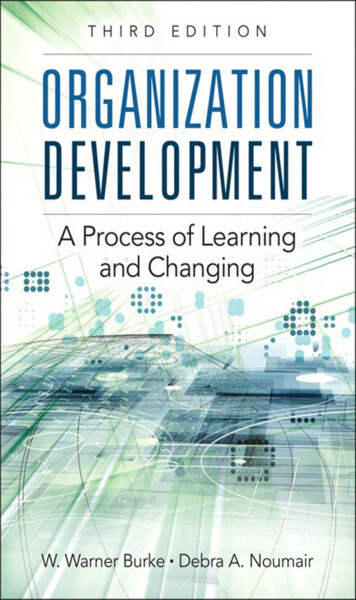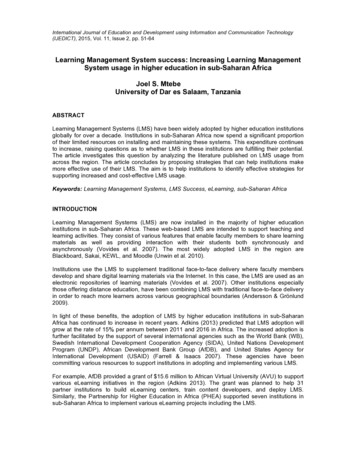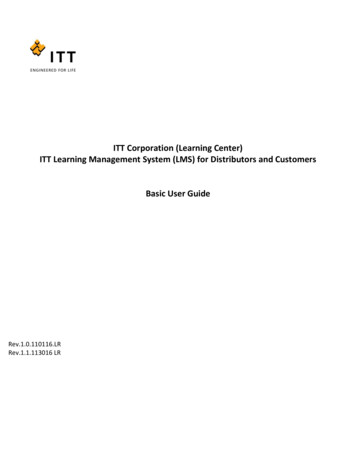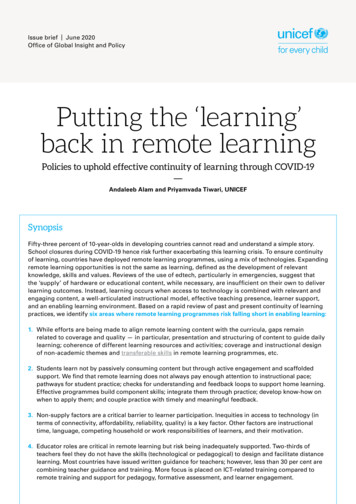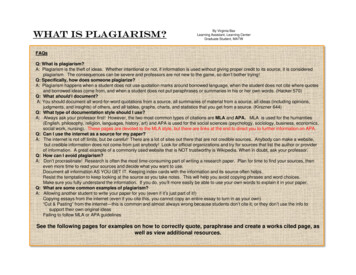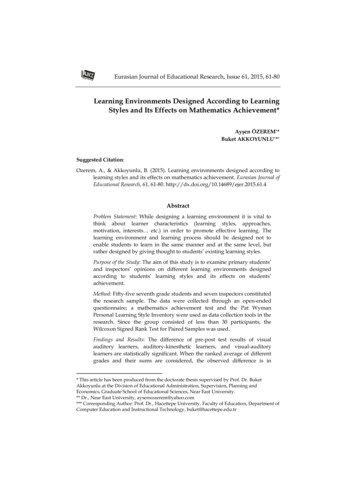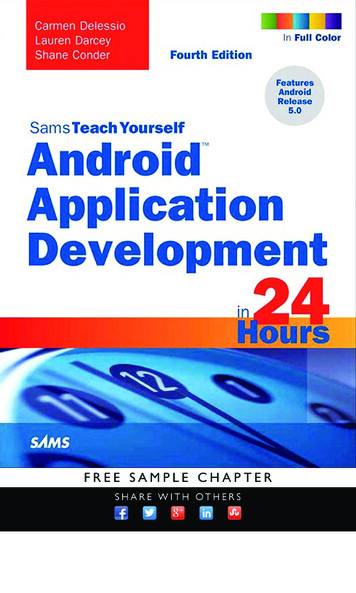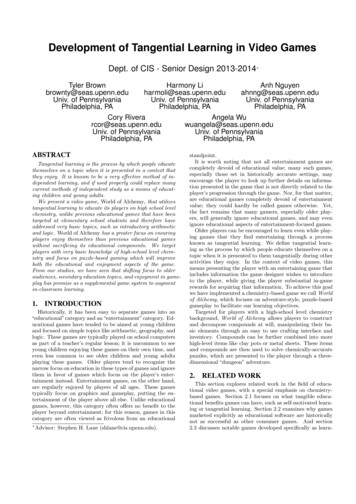
Transcription
Development of Tangential Learning in Video GamesDept. of CIS - Senior Design 2013-2014 Tyler BrownHarmony LiAnh ahnng@seas.upenn.eduUniv. of PennsylvaniaUniv. of PennsylvaniaUniv. of PennsylvaniaPhiladelphia, PAPhiladelphia, PAPhiladelphia, PACory RiveraAngela Wurcor@seas.upenn.eduwuangela@seas.upenn.eduUniv. of PennsylvaniaUniv. of PennsylvaniaPhiladelphia, PAPhiladelphia, PAABSTRACTTangential learning is the process by which people educatethemselves on a topic when it is presented in a context thatthey enjoy. It is known to be a very effective method of independent learning, and if used properly could replace manycurrent methods of independent study as a means of educating children and young adults.We present a video game, World of Alchemy, that utilizestangential learning to educate its players on high school levelchemistry, unlike previous educational games that have beentargeted at elementary school students and therefore haveaddressed very basic topics, such as introductory arithmeticand logic. World of Alchemy has a greater focus on ensuringplayers enjoy themselves than previous educational gameswithout sacrificing its educational components. We targetplayers with very basic knowledge of high-school level chemistry and focus on puzzle-based gaming which will improveboth the educational and enjoyment aspects of the game.From our studies, we have seen that shifting focus to olderaudiences, secondary education topics, and enjoyment in gameplay has promise as a supplemental game system to augmentin-classroom learning.1.INTRODUCTIONHistorically, it has been easy to separate games into an“educational” category and an “entertainment” category. Educational games have tended to be aimed at young childrenand focused on simple topics like arithmetic, geography, andlogic. These games are typically played on school computersas part of a teacher’s regular lesson; it is uncommon to seeyoung children enjoying these games on their own time, andeven less common to see older children and young adultsplaying these games. Older players tend to recognize thenarrow focus on education in these types of games and ignorethem in favor of games which focus on the player’s entertainment instead. Entertainment games, on the other hand,are regularly enjoyed by players of all ages. These gamestypically focus on graphics and gameplay, putting the entertainment of the player above all else. Unlike educationalgames, however, this category often offers no benefit to theplayer beyond entertainment; for this reason, games in thiscategory are often viewed as frivolous from an educational Advisor: Stephen H. Lane (shlane@cis.upenn.edu).standpoint.It is worth noting that not all entertainment games arecompletely devoid of educational value; many such games,especially those set in historically accurate settings, mayencourage the player to look up further details on information presented in the game that is not directly related to theplayer’s progression through the game. Nor, for that matter,are educational games completely devoid of entertainmentvalue; they could hardly be called games otherwise. Yet,the fact remains that many gamers, especially older players, will generally ignore educational games, and may evenignore educational aspects of entertainment-focused games.Older players can be encouraged to learn even while playing games that they find entertaining through a processknown as tangential learning. We define tangential learning as the process by which people educate themselves on atopic when it is presented to them tangentially during otheractivities they enjoy. In the context of video games, thismeans presenting the player with an entertaining game thatincludes information the game designer wishes to introduceto the player, while giving the player substantial in-gamerewards for acquiring that information. To achieve this goalwe have implemented a chemistry-based game we call Worldof Alchemy, which focuses on adventure-style, puzzle-basedgameplay to facilitate our learning objectives.Targeted for players with a high-school level chemistrybackground, World of Alchemy allows players to constructand decompose compounds at will, manipulating their basic elements through an easy to use crafting interface andinventory. Compounds can be further combined into morehigh-level items like clay pots or metal sheets. These itemsand compounds are then used to solve chemically-accuratepuzzles, which are presented to the player through a threedimensional “dungeon” adventure.2.RELATED WORKThis section explores related work in the field of educational video games, with a special emphasis on chemistrybased games. Section 2.1 focuses on what tangible educational benefits games can have, such as self-motivated learning or tangential learning. Section 2.2 examines why gamesmarketed explicitly as educational software are historicallynot as successful as other consumer games. And section2.3 discusses notable games developed specifically as learn-
ing games, with a particular emphasis on chemistry-orientedgames that may have some overlap with this project.2.1Learning in Video GamesKurt Squire and his colleagues studied learning via thegame Civilization III [6]. For reference, Civilization gamesare strategy games that focus on building up civilizations(e.g. Romans, Mayans, etc) from the Stone Age to the Modern Era and beyond. Players encounter other civilizationsduring play, and have to manage economic pacts, political alliances, and military conflicts with these other civilizations.Subjects in this study were fifth and sixth graders with belowaverage scores in social studies. By playing the game andcollaborating with their peers, the participants were gradually exposed to many historical concepts, such as the namesof certain historical military units and various landmark historical inventions like agriculture or writing. By the end ofthe study, most participants had developed a greater appreciation for history and had acquired much better grades intheir social studies courses; all received As while previouslyhaving Bs and Cs. One of the participants even began tostudy his preferred civilization outside of game times, reading history books about them for his own enjoyment. Eventhough Civilization is a popular consumer game, it managedto expose the players to a variety of real-world concepts, likecosts of prolonged military engagements, as well as the historical facts scattered throughout the game and availablein the in-game “codex”. While these students had typicallyfared poorly in class-based instruction, the direct experience, challenge, and fun provided by the game allowed themto explore these concepts directly in their own way, whichyielded real-world learning benefits, as indicated by theirimproved social studies grades. Player motivation to beatthe game and continuous tangential exposure to real-worldtopics combine to make a very effective model for learning.Merrilea J. Mayo analyzes the benefits of games over traditional classroom education, and how these concepts mightbe applied to education in science, technology, engineering,and mathematics [4]. In her analysis she describes how motivation and participation are key differences between learning something in a game versus learning it in a traditionallecture. A game provides instant feedback and immersionin a given scenario, whereas students in a classroom tendto sparingly interact with the material. Player control overlearning tasks are also cited as another important factor;player motivation to complete an immersive task of theirown choosing leads to greater net benefits in learning. Theplayer seeks out what they want to know, rather than beingspoken to about something they are not involved in and maynot have any interest for. Interactive instruction in subjectslike physics proved to be particularly effective for this veryreason. The amount of time people invest in gaming andthe benefits of interactive activities for learning make videogames an excellent platform for delivering educational content. In fact, games like Supercharged! or Virtual Cell (bothdiscussed in the article) yielded significant benefits in learning over lecture-based instruction, since players were allowedto explore electromagnetism and cell biology, respectively, invery engaging contexts at their own pace.2.2Failings of Educational GamesIn their article on the boom and bust of educational games,Klopfer and Osterweil describe the history of educationalgames and the failings of some notable educational games[3]. The main point they make about poor educationalgames is that they tend to focus on just facts and lists of features, rather than developing actual gameplay. These typesof games try to market themselves towards some ambiguousdefinition of academic curricular standards, and often feature rote memorization in drill-and-practice exercises. Themost successful educational games are those that are actually intellectually challenging, and these games focus onactual problem-solving and creativity, rather than appealingto some nebulous idea of academic advancement. Player enjoyment is also an effective component for learning games.Thus a balance is necessary when designing a learning game.By focusing solely on fun activities the learning opportunities may be wasted, and if the game focuses solely on beingeducational it may bore the player, hampering the learningprocess or even causing them to abandon the game altogether.2.3Notable Learning Games for ChemistryDuring the course of our research we have found that therewere not many successful chemistry-based games, especiallywhen compared to mass-market history- or physics-basedgames, such as the Civilization series or Kerbal Space Program. Generally these chemistry games tended to be simplequiz or memorization affairs, or featured chemistry as a verytangential component. We did come across a few notablechemistry games, namely Legends of Alkhimia, Elemental,and Foldit.Legends of Alkhimia is a chemistry-based adventure gamewhere puzzle solutions are derived by working on compoundswithin the game’s chemistry lab interface [5]. Alkhimia communicates laboratory practices and the process of scientificinquiry quite well. This game seems to be at about the samegranularity of knowledge that we want to work on, but wehave focused more on how specific elements and moleculesinteract with each other, as opposed to laboratory practices.Our design also tries to be more accessible to less chemistryoriented audiences.Elemental is an atom assembly game developed at theUK’s Bournemouth University [1]. Players have to “shoot”subatomic particles into a circular game area that resemblesan atom and then “catch” them in their appropriate atomicregion, with the goal of creating elements with progressivelyhigher atomic numbers. Particles that leave the circulararea (i.e. the player was not able to catch them) increasethe ambient radiation level, and once radiation reaches a certain level the player loses. Elemental suffers from repetitivegameplay, and is very direct in its learning goals. Being toodirect may cause an aversive reaction in the player, since thegame is clearly just an educational tool with weak gameplay.Our design seeks to address this issue of directness by placing puzzles and goals in an adventure-based environmentthat may mask their learning-oriented nature.Foldit is a rather well-known academic game that abstracts protein-folding as puzzles [2]. The object of this gameis for players to form correctly folded proteins, by avoidinganomalies such as “clashes” and “voids”. These occur whencertain structures are too close together or far apart, respectively. More stable designs that take advantage of conceptslike hydrogen bonds also result in a better score. Collaboration in developing solutions is highly encouraged, andeffective solving algorithms often spread quickly among the
player community. However, as a learning game it has someissues. While protein structures are realistically represented,to the average player these may seem like arbitrary puzzlestructures. Foldit is too high-level for our goals; from achemistry standpoint it does not seem to deal with any ofthe specific atomic structures of these proteins, instead justfocusing on the puzzle-like nature of a chemically abstractprotein shape. Including additional information about thespecific structures at play could enhance its learning potential. We attempt to solve this problem in our own gameby having item descriptions in the game’s inventory window that lists the chemical composition and functions of theplayer’s items. That said, Foldit is a great example of whatthis project aims to accomplish in terms of tangential learning. Nearly every structure with which the players work isa real protein fold, and it becomes very easy for motivatedplayers to find more information on the protein one whichthey are working.3.SYSTEM MODELWe present a prototype, World of Alchemy for a new typeof educational game based wholly on tangential learning.World of Alchemy focuses on providing the same level ofenjoyment to players as standard video games with additional educational benefits.World of Alchemy is a chemistry-focused adventure gametargeted at middle- to high-school age students who havehad little to no prior chemistry experience. We choose tofocus this game on chemistry for two reasons: first, chemistry is a topic relatively unexplored in video games; mostpopular video games that use tangential learning cover history (e.g. the Civilization series and the Call of Duty series),logic (e.g. The Logical Journey of the Zoombinis), or physics(e.g. Kerbal Space Program and the Portal series) since theyfit naturally into the settings behind those games. We hopeto show that with proper game design, even topics whichat first glance do not seem to work well in video games cansuccessfully be taught to players using this medium. Another reason we focus on chemistry is because it allows usto present a number of chemically-based attacks or puzzles(such as a monster breathing fire) which might appear likethe typical magical attacks players might expect to find in afantasy or adventure game but can be explained using standard chemical reactions. In this way, we can improve theplayer‘s enjoyment of the game by presenting them with thesort of gameplay they expect from a fantasy game while exercising their critical reasoning and skepticism by encouragingthem to think carefully about what the scientific explanationbehind the apparently magical effect they are seeing mightbe so that they can counter or reproduce the effect.3.1Combat SystemAs players will be more amenable to learning through ourgame if they are enjoying the game while they play it, we focus on the gameplay portion of the game, working first to design a fun combat system and puzzle system and then working chemistry concepts naturally into these systems. Weallow players to fight both non-player characters and otherplayers, as many players enjoy player-versus-player aspectsof games and may get additional motivation from improvingtheir characters to beat other players. In addition, combatcan be utilized as a break between puzzles, giving the playersomething different for a change, as well as allowing for alightweight review of previous concepts, like using acid toneutralize an enemy limestone golem.3.2GraphicsSince the target audience is older, the game features amore realistic looking worlds and characters to be more accessible to our audience. This not only affects the design ofour environment, but also our player and non-player characters. In doing so, we aim to foster an immersive settingfor a large audience that may not play role-playing games,such as the one proposed, on a regular basis.3.2.1EnvironmentIn line with the world‘s design, much of the game willtake place in ruins. The only dungeon is designed to teachacids and bases. Of acid-base reactions, one of the mostcommonly taught reactions is the reaction between limestone and acid. Since many historical buildings were builtout limestone, particularly those in Ancient Egypt and inGreco-Roman states, most of our game will be set in a desertland. The structures in the game will be directly based onancient building ruins from the Greco-Roman period in Jordan, particularly the Petra treasury and the fountain meeting area from Jerash. These structures are not massive butalso awing in their great architecture, allowing for audiencesto immerse themselves through gameplay.Figure 1: The player’s initial view of the dungeon3.2.2Player Character (PC)In order to combat the stigma that games are cateredtowards men, the PC will be a gender-ambiguous character.The PC has been planned with cloaks, as they are travelingalchemists. For stylistic and practical purposes, we havechosen to mask the lower half of the player characters‘ faces.Having part of the face visible will allow players to connectwith the PCs. However, masking the lower half will allowthe resulting model to have a lower polygon count, sincewe can obscure the detail of the lips and the nose, whichgenerally account for most of the polygon count on the face.3.3Non-Player Character (NPC)The game will first feature NPCs that are simply enemiesthat try to attack the PC while the player moves around themap. This adds a combative element that aids in immersionand increase enjoyment. Since the environment is made oflimestone, the first NPCs featured will be made of limestone
to fit the environment and to aid in the puzzles that also usethis compound.3.4PuzzlesWorld of Alchemy contains a number of chemistry basedpuzzles (Figure 2) which are used to illustrate common chemistry concepts to students. We focus on acid reactions withbases, lack of reaction with transition metals, electro-chemistry,and hydrolysis.Figure 4: Top-down view of second floor.4.1.2Figure 2: A simple puzzle4.SYSTEM IMPLEMENTATION4.14.1.1GraphicsCharactersThe current iteration of the game features two characters:the player character, and the limestone golem (see figuresbelow). Both of these characters were modeled, rigged andanimated outside of Unity. We chose not to use stock Unityassets as each of these characters interact in a particularmanner. Thus, in order to show the full extent of interaction (i.e. visual cues from chemical interactions, etc.), wehave created our own assets to best suit our needs. Bothcharacters are low in polygonal count, and utilize Unityenhanced shaders to achieve an optimal run time while theplayer is playing the game.EnvironmentThe game features a two-floor cave with multiple rooms.The map is designed to reduce “back-tracking”, or returningto a previous room, in order to reduce frustration and to reward progress in the game. The map is one contiguous roomthat allows the player to return to previous rooms if desired.In order to encourage forward movement in the map, thereare pools of acid scattered through the map that discouragethe player from walking into these areas by decreasing theplayers health. In the case when a player‘s health reacheszero, the player is automatically re-spawned, or returned tothe map with full health, and placed at the closest passed“check-point”. These check-points have been places at theentrance of each room. Once a character has passed a particular check-point, the player will be re-spawned to the latestpassed check-point after his or her health reaches zero.Figure 5: Player character model4.24.2.1Figure 3: Top-down view of first floor.Items and InventoryItemsUsing the Unity game engine, interaction with items isimplemented with a group of control scripts that can beattached to game objects. These scripts include a pickupscript, which prompts the player to pick up the item witha key press when they approach. The pickup script thenadds the item to the player‘s inventory (Figure 7). Thedata for each item is retrieved from the dat
games, such as the Civilization series or Kerbal Space Pro-gram. Generally these chemistry games tended to be simple quiz or memorization a airs, or featured chemistry as a very tangential component. We did come across a few notable chemistry games, namely Legends of Alkhimia, Elemental,
